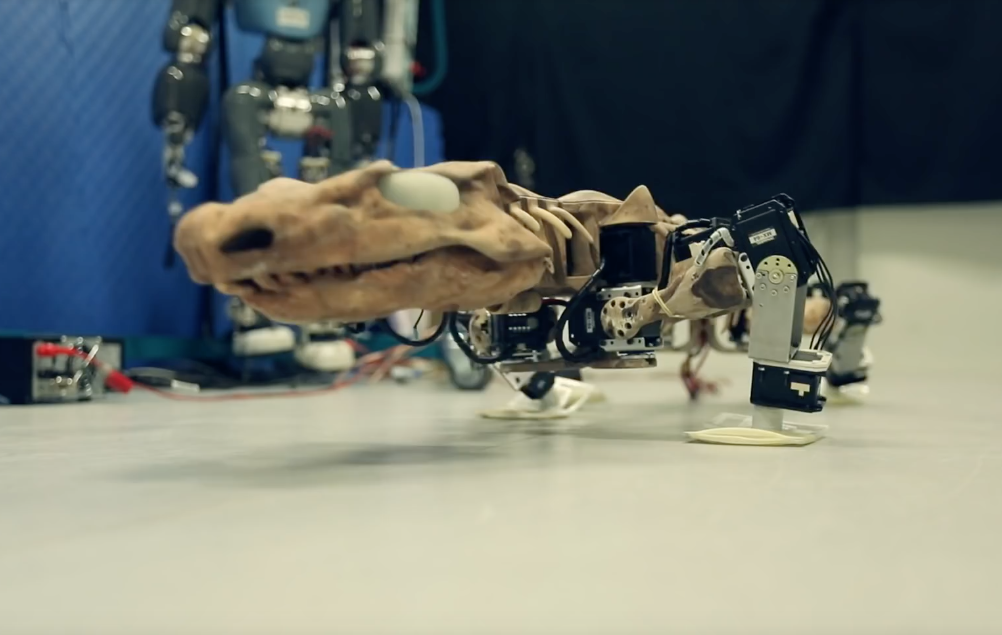It Takes a Smart Robot to Mimic a Reptile
When researchers built a robot to sprawl like a prehistoric reptile, they were in for a surpriseFig 6. Digital reconstruction of Orobates pabsti (MNG 10181) from A Three-Dimensional Skeletal Reconstruction of the Stem Amniote Orobates pabsti
Orobates pabsti (described in 2004) lived during the early Permian period 280 to 290 million years ago, long before the dinosaurs (245–66 million years ago). Few other land-dwelling vertebrates that walk on four legs (tetrapods) have been found from so long ago. But Orobates’ skeleton was “exquisitely preserved,” which created an excellent opportunity for researchers in paleontology to try to figure out how the lizard-like animal moved. And reverse engineering its movements can tell us a lot about how it lived.
So here is what they did:
1. The paleontologists scanned the whole Orobates fossil in 3D and used the results to construct a digital model of the skeleton. They could then animate it on the screen as a “digital marionette.” Studying the marionette meant that they could figure out the range of motion for each of the joints.
2. Of course, range of motion is only a limit (how far can a joint bend or stretch?) Orobates would not use its whole range of motion just to walk. Fortunately, they also had Orobates’ fossil footprints. They scanned these tracks and programmed their digital Orobates to walk inside the scans.
3. Problem solved? Well, not quite. So far, it’s all digital. What works on screen might not work in real life, which features many problems we do not see or foresee. So the researchers turned next to living animals that have somewhat the same body type as Orobates. That way, they would see what works in actual (not virtual) three dimensions, a place where non-programmed events can happen.
Orobates’ skeleton had led researchers to believe that it moved with a “sprawling gait,” like that of a lizard or salamander today. X-ray video from the live animals they studied was used in order to “define” the movement so that it could be reproduced on the computer. When it was rendered digitally in that way, they reduced it to four parameters ( power, balance, precision, and ground reactive force).
4. This new information from living animals enabled them to create a “dynamic simulation” using the digital marionette skeleton and the digital footprints. They could then study all the possible outputs to pick the most likely options for what the animal did.
5. But something was still missing. Even detailed computer simulations cannot account for everything. Digital life forms do not experience gravity, for example. The paleontologists needed an actual 3D model that would move around the lab (3:25 mark).
6. So they produced a robot Orobates, an “ORO-bot.” And when it did move around the lab, they learned something unexpected. Orobates probably didn’t sprawl:
“The researchers think that Orobates moved with a relatively upright gait and had more capabilities than expected for such an early land dweller and that means a different ecology. A more mobile animal might be more adept at picking through the landscape and perhaps be able to travel further from water than scientists had predicted.”
Researchers had thought that this “relatively advanced style of walking” had only evolved much later over millions of years in tetrapods but Orobates
… held its belly off the ground, and had a stable, efficient gait without a lot of side-to-side, salamander-like undulations. That style of walking probably helped the animal conserve energy. Carolyn Gramling, “A four-legged robot hints at how ancient tetrapods walked” at ScienceNews
One reason the researchers are so interested in this ancient creature is that they think it is one of the earliest animals whose offspring could live entirely on land (amniotes). Animals like frogs and toads (amphibians), by contrast, must go through a water-living stage first, as tadpoles. If Orobates was more like a lizard, as the paleontologists think, it would have much more flexibility in terms of the landscapes it colonized.
Could we be surer about how Orobates walked at this point? Yes, if we could invent a time machine to go back and see! Meanwhile, in the hope that other ancient animal movements can also be studied, the researchers have made their methods available free online.
One outcome of the researchers’ efforts may be that future audiences will expect more realistic “Jurassic Park”–style films.
Note: The research paper is open access.
See also: That plant is not a cyborg But a clever robotics expert has wired it to move a cart to reach sunlight
and
Can a stuffed toy turn into a robot? Maybe to amuse a sick child? With the right skin, yes.
